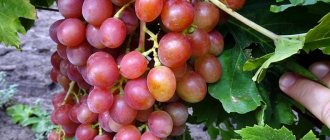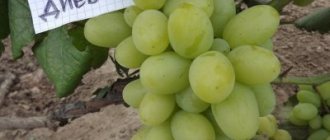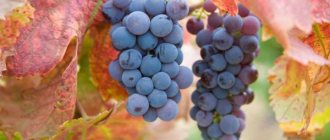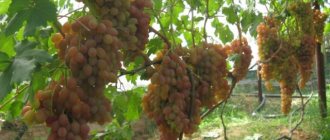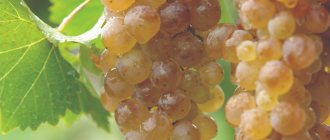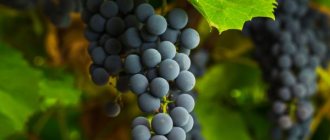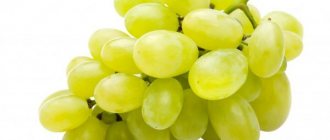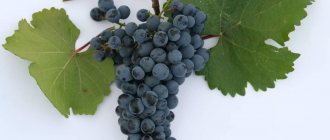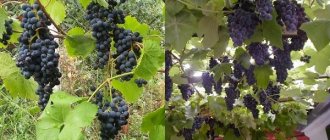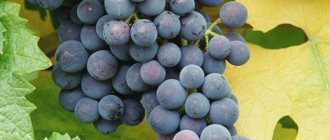Fruits and berries » Grapes
0
834
Article rating
Kira Stoletova
Marinovsky grapes are considered an unpretentious variety. The main elements of caring for it are pruning and disease prevention. It is suitable for lovers of berries with a harmonious sweet and sour taste. This is ideal for making homemade wines.
Growing Marinovsky grapes
Marinovsky grape variety - specifics of uncovered cultivation
Most grape varieties are very sensitive to cold.
The exception is uncovered or frost-resistant varieties. Marinovsky grapes are one of these, capable of withstanding frost down to -30 C. Marinovsky was obtained through long-term selection of several varieties. It is very unpretentious: it is undemanding to the composition of the soil, responds well to watering, but also tolerates drought, and does not need frequent feeding. Its berries are not too large, but have a good taste, are stored for a long time and are easily transported. Marinovsky is a wine variety, but most amateur gardeners grow the crop for fresh berries.
Main characteristics
The parent pair is July and Amur grapes. These species have contrasting properties, which led to the high resistance of the crop to frosts down to -30°C. It does not need to be covered for the winter, hence the name of the grape - uncovered. Temperature changes can slow down the rate at which grapes ripen.
Marinovsky grapes are unpretentious to the soil, love water, but easily tolerate its lack, and do not need constant fertilization. The bunches are stored and transported for a long time without damage, the yield is high: up to 10 kg per bush. The species is viniferous, but is often grown for fresh consumption.
Description of the bush and vine
The bush has a high density of dark green leaves and grows quickly. Due to this property, it is often used to decorate the garden. The vine has high fertility, which often creates stress on the bush.
To avoid reducing the size of the berries, gardeners recommend trimming the shoots, leaving about 5 eyes. This reduces the number of bunches but increases the size of the berries.
Fruit characteristics
The clusters are medium in size, cylindrical in shape, the berries are densely spaced. Weight reaches 220-310g. The grapes are small, their diameter is 12 mm. They are round in shape and deep blue in color. The skin is strong, the flesh is rich.
Calorie content is about 650 kcal/kg. Marinovsky grapes are rich in glucose, which is quickly absorbed, helps blood formation, and reduces cholesterol levels. Acidity reaches 5 g per 1 liter.
Description of the uncovered grape variety Marinovsky
Grapes are a southern plant and prefer sunny, long summers, warm autumns, and the absence of severe frosts in winter. This greatly limits the growing area of the crop. Breeders are constantly developing new varieties of grapes that can withstand cold and rain. It is this category that includes non-covering varieties. You can read about uncovered sweet grape varieties for the Moscow region here.
They got their name for their high frost resistance. Plants overwinter without necessarily covering. In this case, neither the vine nor the eyes are damaged, and the bushes remain fruitful. However, they are all artificially bred hybrids, since the culture is naturally heat-loving.
The hybrids of the Isabella variety are considered the most frost-resistant plants. The plant can tolerate frosts down to -40 C.
The variety was developed through long-term selection carried out at the Ya. I. Potapenko Scientific Research Institute of Agriculture. First, they crossed Hamburg Muscat and Northern Muscat - in this way they got a new variety called July. And then they cross-pollinated it with Amur grapes to give the hybrid frost resistance. The grapes are unpretentious. There is no need to cover the bushes for the winter, except for the youngest ones; you don’t have to worry about watering, as well as draining excess groundwater. The grapes grow in record time, so at the same time they can serve as a covering for a gazebo or arch.
Marinovsky grapes are a long-lived variety. Planted on a personal plot and without any care, it will easily live for several decades, delighting its owners with delicious berries.
Unpretentious grapes for beginners - Marinovsky variety
Today, happy owners of land plots located outside the city are increasingly using them not for harvesting vegetables and fruits that will feed the whole family, but for a relaxing holiday in the lap of nature from the noise, bustle and hassle of work. How pleasant it is to sit in a gazebo entwined with greenery, enjoying the contemplation of flowering plants and inhaling fresh air filled with the smells of herbs, how many positive emotions such a simple pastime gives!
Vinograd Marinovsky will be the ideal solution for arranging such a green island of peace and serenity. And fans of homemade wines will definitely enjoy its aromatic berries. Among the huge variety of grape forms, there are few varieties that can compete with it in terms of unpretentiousness and ease of care.
History of variety selection
The Marinovsky variety is the result of breeding work by scientists from the Ya. I. Potapenko National Research Institute of Agriculture.
To obtain it, scientists crossed grape varieties that have very valuable, but opposite properties: July (obtained from the cross-pollination of Hamburg Muscat and Severny) and Amur grapes. Thanks to the qualities inherited from the parents, the bred form of the plant is characterized by high resistance to frost.
The grape is able to bravely endure cold temperatures down to -30C, while the variety with the sonorous name Marinovsky does not need shelter at all for the winter period, thereby making it easier for gardeners to take care of themselves. On hot summer days, its dense greenery will serve as a reliable shelter from the scorching rays of the sun, giving summer residents alluring shade and coolness.
Characteristics of the variety
| Purpose of the variety | wine |
| Sugar content of the variety | 19 -21 % |
| Acidity of the variety | 4-5 g/l |
| Bunch shape | cylindrical-conical |
| Bunch weight | 280 - 500 g |
| Berries shape | oval |
| Berry weight | 4-6 g |
| Berry color | rich dark blue to black |
| Frost resistance of the variety | up to - 30 ºС |
| Taste | harmonious |
Hybrid grapes Marinovsky is included in the group of varieties that are characterized by medium or medium-late harvest ripening; the description of this wine variety should begin with its botanical characteristics.
Grape bushes are characterized by a fairly high growth force, exceeding the average level. The shoots are covered with graceful leaves of medium and large sizes, attracting attention with their unusual shape.
The significant size of the leaves allows the vines to create shade and keep cool under their canopy even on hot days. Along the edges of the leaves there are dome-shaped teeth, greatly expanding at the base.
Young shoots are painted in an extraordinary red hue, giving them extravagance and making them a memorable element of the decor of a gazebo, veranda or balcony.
The variety is characterized by large cylindrical-conical clusters with well-developed blades in the amount of 1-2; the weight of one bunch averages 280-300 g. If the clusters on a bush are rationed, their weight can reach up to 500 g, and in some cases up to 1 kg. Small, slightly oval fruits of a rich dark blue color, close to black, grow on them very closely to each other. The usual berry sizes are 14 mm long and 12 mm wide. Their taste is simple, not significantly distinctive, but harmonious, leaving behind light aromatic notes inherent in Amur grape forms. The juicy pulp, which contains small seeds, is located inside a durable shell. The juice squeezed from it is not colored.
The sugar content in fruits is about 19-21%, regardless of the climatic characteristics of the grape growing area. The acidity of the juice is about 4-5 g/dm³. Most often, the Marinovsky variety is grown to make sweet juices from its berries and consume them fresh. They are also used to make homemade white and rose dry table wines of excellent quality.
The variety can be overloaded with harvest, so its bushes require rationing of the number of bunches. It is recommended to cut the vine into 4-6 eyes. The shoots are characterized by a good degree of ripening.
Advantages of the variety
The Marinovsky hybrid form has many valuable qualities, thanks to which this grape has enjoyed the well-deserved love of gardeners for many years; special attention should be paid to their description:
- The variety is completely undemanding in care. Even inexperienced gardeners who don’t have a lot of time and don’t want to spend a lot of effort taking care of the plants they planted can cope with its cultivation.
- The vines of this grape are distinguished by high fruiting, which is not affected by the vagaries of the weather, and good reproduction.
- The berries of the variety tolerate transportation well, maintaining their presentation and without being damaged.
Some features of growing the variety
Marinovsky is characterized by increased resistance to mildew (3 points) and gray rot. This greatly simplifies the process of growing and caring for grapes, since this feature reduces the number of treatments of the plant with pesticides. But its resistance to infection with oidium is significantly lower.
Since this hybrid has Amur roots in its pedigree, it has fibrous roots that are close to the soil surface. Because of this structure of the root system, grapes respond well to regular watering.
Despite the high frost resistance of this grape form, newly planted young bushes must be covered for the winter. Adult plants do not require shelter.
The Marinovsky variety will help to create a country idyll on any site, delighting not only with the pleasant coolness and beauty of its flexible vines, but also with heavy clusters of juicy, tasty berries covering them abundantly, which can be used in every home, no matter what the preferences of its owners.
Properties
Uncovered Marinovsky grapes are originally a wine variety. In fact, it is grown as a universal fruit: the berries are consumed fresh, used for preservation and, of course, for making wine.
The taste of Marinovsky berries is described as quite simple, but harmonious. This is the right balance of sweetness and slight sourness, which is the main appeal of dessert varieties. At the same time, the berries retain not only their taste, but also their aroma for a long time. Marinovsky berries are well stored and transported without losing their presentation.
The taste of the grapes is determined by the degree of ripening. Marinovsky is classified as a mid-late variety, so despite the beautiful rich color of the berries, the grapes can only be harvested in October.
Calorie content
Marinovsky belongs to the dark grape varieties, and the latter always have a higher calorie content than green ones. The indicator for Marinovsky grapes is 62–65 kcal/100 g. The value depends on the degree of ripening and the amount of accumulated sugar.
Benefits and harms
Marinovsky has all the advantages and disadvantages of dark grape varieties. But, given how difficult it is to grow grapes in northern latitudes, both the simplicity of taste and the small size of the berries are not a decisive factor when wanting to eat sweet, tasty berries.
The advantages of the variety include the following:
- dark grape varieties are richer in easily digestible glucose, so they are indispensable in the diet of weakened or sick people;
- Marinovsky, due to its high content of bioflavonoids, is especially recommended for women, as it improves hematopoietic function;
- like other dark grape varieties, it is indicated for liver diseases;
- Marinovsky helps reduce cholesterol levels in the blood, which has a very positive effect on the functioning of the heart and blood vessels;
- berries have a weak diuretic effect and can reduce high blood pressure;
- Constant consumption of dark grapes reduces the risk of cancer and prevents the growth of cancer cells;
- the amount of antioxidants in dark grapes is 12 times higher than in light ones. Marinovsky is especially recommended for elderly, weakened people, prone to colds.
- in case of exacerbation of gastric diseases, especially gastritis and ulcers, you should avoid berries;
- dark grapes contain little iron and even reduce its level somewhat. This should be taken into account by people prone to anemia;
- The calorie content of the fruit is not so high as to prohibit its use by overweight people. But for patients with diabetes, it is better to eat green grapes.
Read more about the benefits and harms of grapes for the body here.
Acidity
With sugar content not exceeding 21%, acidity reaches 4–5 g/l. This ratio makes Marinovsky grapes an excellent raw material for making table wine.
Description of the variety Romeo
This grape belongs to the table variety; its grapes have an unusual cone shape.
Bushes and tops
Romeo's bushes grow strongly, sprout green shoots with a brown tint, on which grow large round leaves, jagged at the edges, of a rich green color, with deep notches. Blooms with flowers of different sexes.
Productivity
The vine ripens along the entire length of the growth. Usually 35 eyes are left, otherwise a large, beautiful and tasty harvest will be difficult to grow. The variety is able to independently regulate the load if it cannot cope with the harvest. If the cluster density is high, some berries dry out and fall off.
The norm is 35 buds per vine; pruning is done at 6–8 buds.
Ripening time
The harvest ripens in late summer in approximately 130–140 days, so Romeo grapes are a medium-late ripening variety.
Important! Do not delay harvesting the Romeo variety, otherwise it will crack and lose its presentation.
Bunches and berries
The clusters grow along the entire length of the growth, are of medium density, large, and resemble a cone in shape. The average weight is 1 kg, the maximum is 2 kg, they usually grow at least 0.7 kg.
The berries are oblong in shape, tapered at the tips, and the color is dark blue, dark pink or dark purple. Each berry weighs 10–12 g, has a jelly-like pulp that is not particularly sweet, but pleasant to the taste, and a not very dense skin; there are 2–3 seeds inside. Fruit sugar level is 17–18%, size is 3.8x2.3 cm.
Disease resistance
The practice of growing Romeo has not yet confirmed many varietal characteristics, but, according to the description of its creator, it can withstand temperatures down to -23°C and is well resistant to diseases and pests.
Transportation of grapes
The variety is capable of cracking, so it does not tolerate shaking during transportation. This makes it unprofitable for growing for sale.
Did you know? To make 1 bottle of wine, 600 grapes are used.
Characteristics of the bush
The grape bushes are vigorous, produce abundant green mass, and spread throughout the area very quickly. This feature allows the variety to be used as a decorative one - for covering gazebos, pergolas, and terraces. The Marinovsky grape has a very beautiful and unusual leaf for a grape, and the young shoots are red, which can serve as an additional decoration for a gazebo, arch, balcony, etc.
The grapes are really very beautiful. Its leaves are medium-sized, graceful, bright green until late autumn, the vines are rich red, and the berries themselves are black and purple. This combination is very attractive.
The main feature of the vine is its very high reproductive rate. On the one hand, this ensures a harvest in any weather, but on the other hand, it places a large load on the bush. When overloaded, the berries become smaller, the clusters become lighter and looser. Experienced gardeners recommend pruning grapes and leaving no more than 4-6 eyes for shoots. The number of clusters will be smaller, but their size will be larger and the taste of the berries will be sweeter.
Bunch
Marinovsky's clusters have a conical-cylindrical shape, quite dense, which makes harvesting easier. The average weight of the bunches is 260–300 g, but when molding the vine, you can get bunches weighing 500 g or even 1 kg.
Descriptions and characteristics of varieties
Depending on the color and scope of the berries, the described grape varieties are divided into several varieties:
- seedless;
- canteens;
- technical.
Seedless
- Kishmish Novocherkassk has an early ripening period - 110 days. The variety was developed through selection of the Villars blanc and Mechta varieties. The bush is small in size, the leaves are round. The fruits are pale pink in color, weighing up to 450 g. The weight of one berry is up to 3 g, round or oval in shape. It is resistant to powdery mildew. The main advantages are the absence of seeds and the rapid survival of seedlings. The disadvantage is the rapid spoilage of fruits on the stems.
- Yasya is a new seedless grape variety that was developed by crossing the Rusvena and Ogonyok varieties. The bush vine is vigorous, the leaves are green. The bunches ripen in 115 days and gain weight up to 1 kg. The weight of one berry is up to 10 g, the color of the peel is purple, the pulp has a pink tint. The advantages of the variety are early ripening and partial immunity to fungal infections. The disadvantage is the tendency for the skin of the berries to crack.
Dining rooms
- Alexa is a variety developed by crossing the varieties Birunitsa and Vostorg. The shoots of the bush are vigorous, the leaf blades are large, have a green tint, and are slightly pubescent below. It is characterized by an average ripening period of 120 to 135 days. The bunches are cylindrical or conical in shape and weighing up to 1 kg. The oval berry weighs 10 g. Advantages include frost resistance and average resistance to fungal diseases. The fruits tolerate transportation well over long distances.
- Zolotinka is an early variety that ripens in 100 days. Bred from the Frumoasa Albe and Korinka Russian varieties. The bush is highly climbing, the leaf blades are small and rounded. The clusters are wide, conical in shape, weighing up to 800 g. The berries are greenish in color and weighing up to 10 g. Resistant to gray rot and mildew. The disadvantage is the lack of immunity to oidium disease.
- The Baklanovsky grape was developed by crossing the Original and Vostorg varieties. It is characterized by early ripening at 110 days. The clusters have a conical shape and reach a weight of 900 g. Round white berries weigh about 7 g. Resistance to putrefactive diseases is high, frost resistance is average. Over the years, there has been a decrease in yield, which is a disadvantage of the variety.
- Kesha muscat grapes are bred from the varieties Vostorg and Frumoasa Albe. It has an average ripening period of up to 130 days. Wide conical clusters weigh up to 1200 g. The berries are white, round, weighing up to 12 g. The variety is frost-resistant and partially resistant to fungal infections. Disadvantage - abundant yield leads to breaking off the stems.
Technical
- The Platonovsky grape variety was bred by crossing the Zaladende and Podarok Magaracha varieties. Ripening time is 115 days. The fruit clusters have the shape of a cylinder, pointed towards the bottom, and weigh 300 g. The berries are medium-sized, round, white, weighing about 2 g, and have a pleasant nutmeg aroma. The taste is sweet. It has a lot of advantages, which include frost resistance (down to –29°C), resistance to putrefactive and fungal infections.
- Muscat Pridonsky is another representative of technical varieties, bred by crossing the Druzhba and Oreon varieties. Ripening time is average - up to 130 days. The bushes are developed and are characterized by strong ripening of the vines. The clusters are cylindrical, weighing up to 350 g. The berries are spherical or oval, weighing up to 3 g, white or pink. The thin-skinned berries have juicy pulp and a nutmeg aroma. The advantages of the variety include frost resistance, as well as average resistance to gray rot and phylloxera.
Growing
The unpretentiousness of the variety makes it extremely easy to care for, which, however, does not exclude some standard procedures.
Marinovsky has good frost resistance. However, this applies to mature, well-developed plants. Young bushes should be covered for the winter.
Planting period
Marinovsky is propagated by seedlings, which is typical for all hybrid varieties. Seedlings should be purchased from trusted nurseries, since the plants' disease resistance is not very high and there is a risk of purchasing infected grapes.
Planting is carried out according to the most usual scheme. However, it is recommended to prepare the soil in advance.
- In the fall, they dig holes for seedlings - 60*60 at least, since the roots of the plant must fit freely into the trench. The best soil is fertile, with medium acidity, but sandy loam is also suitable. If the clay content is high, you can mix the soil with sand.
- Organic fertilizers are applied and covered with a layer of soil.
- In spring, seedlings are planted after steady warming - at an air temperature of at least +19 C. As a rule, this happens in late April - mid-May.
- The seedling is lowered into the hole, covered with soil, and compacted.
- A bucket of warm water is poured under each bush if the ground is dry.
Ripening period
Marinovsky grapes are classified as medium-late grapes; the grapes ripen in 135–150 days. The harvest can be harvested in late September to mid-October.
The timing of warming depends on the air temperature. Thus, lowering the temperature below +20 C increases the ripening period by 1–2 weeks.
Caring for the plant is quite simple. Marinovsky does not require frequent feeding, abundant watering or mandatory drainage of excess moisture. Necessary elements of care include only pruning and disease prevention.
Thanks to its “Amur” ancestors, the plant has fibrous roots that are located close to the ground. This structure determines a good response of grapes to watering.
Disease Prevention
The relative resistance of the variety to gray rot and mildew makes it easier to care for. In addition, the berries are practically not damaged by insects and birds due to their dense, even harsh skin. But you will have to fight with oidium.
Oidium is a fungal disease. The mycelium overwinters in cracked bark and buds and freezes out only in the most severe frosts. As you know, oidium, in principle, prefers wine grape varieties and Marinovsky is no exception.
- The most effective means against powdery mildew is ground sulfur. The substance is sprayed, thoroughly covering the leaves, vines, ovaries, as well as the soil around the trunk. Baths for the bunches are made from colloidal sulfur - they are completely dipped into a vessel with the substance.
- In early spring, as soon as the vine is well ventilated, the vineyard is sprayed with a specialized fungicide - Azophos, Topaz, Skor.
- In the fall, it is recommended to treat the bush with a 3–5% solution of copper or iron sulfate.
You can familiarize yourself with the scheme for treating grapes from diseases and pests in this article.
Be sure to inspect the bushes and remove any dried leaves and shoots. If a disease is detected, all damaged parts of the plant should be burned.
Trimming
Marinovsky grows very intensively, its bushes easily reach a height of 2 m and grow well. In addition, grapes are prone to overload.
- In the spring, shoots must be trimmed, leaving no more than 4–6 eyes. If pruning is carried out in the fall, then save up to 8-9 eyes in case some are damaged by frost.
- You should monitor the bush after the ovary appears. With an excessive number of clusters, the latter develop worse and produce fewer berries. In this case, it is necessary to cut off the excess ovary.
- In the summer, young fruiting vines are pruned to redirect nutrients to the berries.
- Periodically remove dried leaves and shoots. In August, excess leaves are removed from the lower tiers of the bush in order to provide access to the sun.
Read more about spring pruning of grapes at the link.
If grapes are also used for decorative purposes, pruning is carried out taking this factor into account. First of all, clear the door and window openings of the gazebo from vines, remove excess shoots blocking the arch, etc.
Features of cultivation
Proper care ensures a stable, long-awaited grape harvest. The hybrid is grown from cuttings, seedlings or grafting.
Landing
“Long-awaited” is planted at the end of April. In the southern regions, it can be planted in October, providing the young seedlings are well covered for the winter.
Reference! Before planting, it is recommended to dip the roots of the seedlings in a mixture of mullein, clay and water with the consistency of liquid sour cream.
Place and soil
For planting grapes, choose sunny, warm areas, protected from cold northern winds. Planted near the wall of a house, a high fence, next to trees that will provide protection from wind and drafts. The ideal place for landing is written in a separate article.
For full development of the variety, light, loose soil is required. If the soil is clayey, then it is mixed with sand and brick chips. Humus is added to sandy soils. It is necessary to avoid areas with close groundwater.
Watering and fertilizing
“Long-awaited” does not like waterlogging, so it is rarely watered. Abundant watering is carried out only after planting and during the ripening period of the berries.
After the last frost in the spring, the grapes are fed with humus or manure.
At the beginning of summer, 1-2 liter cans of wood ash are added under the bush; it strengthens the root system. Before and after flowering, foliar feeding is carried out by spraying with complex fertilizers. After harvesting, fertilizers containing phosphorus are applied.
Important! Fertilizers applied during berry ripening should not contain nitrogen.
Trimming
In the fall, a long pruning of the bush is carried out, leaving 8 - 10 buds on each of the 20 - 25 shoots. In spring, damaged shoots are removed.
In the summer, pinching is carried out regularly, preventing the bush from thickening so that the sun has access to the berries. Some leaves are removed, which promotes ventilation and eliminates fungal diseases.
Harvest of correctly pruned “long-awaited”
It is necessary to pick ripe bunches in time so that the branches do not break under the weight of the harvest.
Diseases and pests
The “long-awaited” hybrid has average sensitivity to fungal diseases, is resistant to mildew, but is susceptible to oidium. For prevention, the plant is treated with fungicides several times a season. “Long-awaited” is resistant to infection by grape mites and is rarely attacked by wasps and birds.
Shelter for the winter
“Long-awaited” can withstand cold temperatures down to -23 degrees. Even when the buds freeze, the shoots produce a harvest, but one month later.
Important! The hybrid must be covered for the winter in areas with cold winters. Annual shoots are covered regardless of weather conditions
In the autumn, after leaf fall, the vines are treated with a 3% solution of iron or copper sulfate to protect the plant from fungus, mold and rot, the bushes are hilled up and removed from their supports. The vines are tied into bunches and laid on the ground or flooring, sprinkled with earth, dry leaves, pine spruce branches or sawdust. It is recommended to cover the top with agrofibre to prevent the grapes from getting wet. More details on how to properly cover grapes for the winter can be found in a separate article.
Harvest storage
The “long-awaited” bunches are stored for a long time in cellars and storerooms at temperatures from 0 to +7 degrees. In the refrigerator at a temperature of -1 to +2 degrees, the crop is stored for 4 - 7 months.
Regions
The “long-awaited” grape variety has become widespread throughout almost the entire country. It is grown in the south, in the regions of Central Russia. Can be grown in northern regions with denser shelter for the winter.
Growing grapes: tips for beginners
Extreme climate is not a hindrance to sunny berries. And getting a good grape harvest in the second or third year after planting is an entirely achievable goal even for beginners. So, how to stop dreaming and start growing grapes...
First, let's decide on the two most important tasks when growing grapes - choose the place to plant the grapes and the varieties that we will plant. In principle, the grapevine will grow almost anywhere (except for continuous shade), and if you take care of it, at the very least it will bear fruit. However, proper planting in the right place will allow you to get really good harvests with much less effort. Remember that planting a vineyard with seedlings of low-quality varieties will take away your time, energy and good mood. You may be unfairly disappointed in the grapes, although the mistake will be entirely yours.
UNIVERSAL FORMS OF GRAPES
Winters of the new millennium 2005-2006. showed that grape lovers had no reason to be calm. Many well-known forms of southern selection, long cultivated in Russian regions, did not survive critical temperatures.
Two days of snowless November 2010. , when the temperature dropped to -30 degrees, it was enough that not only grapes suffered, but also apple trees, pears, plums, and even cherry plums, which for the first time in many years did not produce a harvest in our region. The situation is well known – a sharp drop in temperature; this is critical for many cultivated plants, but alas, this knowledge does not save you from losses.
In Russia, weather anomalies have always adjusted the selection vector towards more stable and frost-resistant forms. The regularity of anomalies made this work even more urgent, and it must be assumed that breeding work in this direction is unlikely to ever stop.
Once again you are convinced of the timeliness of the Amur forms of A.I. POTAPENKO, which, as always, successfully passed the winter and gave a good harvest, despite, among other things, the hot summer. The involvement of Amur grapes in the breeding process made it possible at different times to obtain such universal interspecific hybrids as Marinovsky, Violet early, Northern shoulder, Flower, and later Amethyst, Neretinsky, Agatam, New Russian and others.
Focusing on this undeniable breeding success, in 2001 we sowed the first hybrid seeds of the Victoria x Marinovsky combination. The couple was not chosen by chance. Marinovsky is an interspecific Euro-Amur hybrid with real frost resistance down to -36 degrees. In Tambov in 2005-2006. endured -37 degrees without shelter. Here in Saratov, last winter I tolerated -36 degrees on a trellis (for three days), and at the same time gave a full harvest. Freezing of the buds of ten-year-old bushes is at the level of 10-20%. There is only one drawback of the variety - damage to the leaf apparatus by oidium. The defeat is partial, usually on the north-eastern side and, as long-term observations show, it is not annual. As a rule, it does not affect the harvest, and preventive treatment with weekly herbal infusions easily eliminates the infection.
Advantages. Longevity, successful use on hundreds of amateur sites. Frost resistance. Large size. Individual clusters – up to 1 kg. and more. Berry 3.5g, black, technologically advanced, with juice yield up to 75%. Consistently high yield. On 4 m2 of arbor formation, adult bushes produce up to 90 kg. berries without periodic fruiting. Of course, with enough moisture. It should be noted here that all Amur Potapenko forms are moisture-loving, their root system is fibrous and is located in the upper soil horizon. The sugar content of berries in almost any region is from 20% and higher, acidity is 6.0 -6.5%. They are extremely productive, while maintaining optimal reproductive performance of the vines under any load. Such parameters of Marinovsky characterize him as a supplier of first-class juice and wine materials. And although not everyone will be satisfied with Marinovsky’s Marinovsky extremely attractive in breeding.
Marinovsky seeds demonstrated their amazing stability. And already at the first stage it became possible to select very early and more stable forms. Summarizing this fact, we can say that literally all varieties and forms of A.I. POTAPENKO, which have undergone more than half a century of selection, are endowed with these same qualities.
All of them are hybrids of the 5th - 7th generation, and this is exactly the level from which cultural forms of interest for industrial viticulture begin; for this, it is enough to recall the Moldovan varieties that have not lost their popularity to this day.
Cultural Amur today is extremely diverse as a source of juice and wine material, since it allows you to obtain drinks of various types, from white and pink (Amethyst) to dark red (Neretinsky, Amur breakthrough, etc.), from quickly maturing wines to those that can be stored for decades.
Winemakers who want to work with them have plenty to choose from.
Considering the above, the selection interest in the Amur Potapenko as a donor of high sugar content, high taste and other equally excellent parameters becomes understandable.
So let's return to our chosen parent couple. The other half is Victoria - a complex euro - amuro - an American hybrid with a female flower, with real frost resistance -260C, with field resistance to major fungal diseases - 2.5 points. A beautiful, large seed with good taste and amazing seed germination naturally pointed to Victoria as the original maternal form. Some disadvantages - sloppiness in fruiting and the tendency of berries to crack - can be overcome through the process of selective selection. The ultimate goal is to obtain frost-resistant table or universal forms in the region of -30-31 ° C, if we rely on the law of temperature averaging mentioned by A.I. POTAPENKO.
As a result, over nine years the following hybrid forms of this combination were obtained and tested.
OPENWORK. The name is given for the beautiful, openwork cut of the leaf. Vigorous. Bisexual. The leaves are large, wrinkled, hard and rough in autumn, like Amur grapes. The vine is of extraordinary color, bright purple, with a lilac tint. Ripens by 90-95%. Brushes are large, standard, from 0.8 kg. and more, two or three per escape, which, of course, requires strict rationing. The berry is white, oval, with an average weight of 8-9g, ripening in July, harmonious taste with sugar accumulation of up to 25% or more. The skin is tender and edible. Acidity 5-6%. The harvest on the bush is stored for a month. The shape is interesting for areas with difficult weather conditions, with late spring frosts. Any stepson on the bush is capable of producing a crop that ripens during August. All top and coppice shoots, without exception, bear a harvest.
In this regard, the form is reminiscent of Marinovsky , on which as soon as you pinch the stepson, the brush is immediately tied. Cuttings root 100%. General vegetation properties, large-growing size and high yield make the form similar to the well-known variety Aleshenkin, but with high resistance to frost and known fungal diseases at the level of the maternal form. There are no chemical treatments carried out on the site. A natural agricultural background is maintained, with wild herbs that are periodically mowed. The soil is sandy. Mineral fertilizers are not used. Any organic residues are used as fertilizing, which during the summer fill shallow holes, one and a half shovels deep, located near the root system of the bushes.
FIELD. The name is given for the special rare taste of the berry, reminiscent of Kodryanka, but with complex shades of field herbs. With high sugar accumulation, up to 25% and above. Vigorous. Bisexual. Brushes – 0.7 kg, cylindrical-conical, two per shoot. Berry – 8.0g, red, elongated, similar to Victoria. On sandy soil it is prone to cracking, which is why it is attacked by wasps and birds. On rich, fertile soil, in the absence of shading and deep preventive watering before ripening, it is possible to avoid these troubles. Preventive spraying of brushes with a solution of tea soda, one to two tablespoons per liter of water, also helps prevent rot and wasps. The field variety ripens in early August. The berry is crispy. Other characteristics are the same as Openwork .
LUCY BLACK. The berry is black, nipple-shaped, spectacular looking, 8.0g. The clusters are large, conical. Female type of flower, but pollinated like Laura, very well, without peas. Ripens August 20-25. The berry is long-lived and is not affected by wasps and birds. The peel and juice are brightly colored red. Taste and other characteristics are the same as Azhurny. The form is universal. Juice separation up to – 80%.
LUCY WHITE. The berry is white, oval, 10-12g, individual berries - up to 15g. The clusters are large, conical. Female type of flower. Pollinates well, without peas. Ripens at the end of August. The berry is stale. The form is universal. Juice separation – up to 80%. Other characteristics are the same.
LUCY RED. Bisexual. Very early. The berry is red, elongated, 7-8g, nutmeg taste. The clusters are cylindroconical. Other characteristics are the same.
EVENING SARATOV. Powerfully tall. Red berry, heart-shaped, with nutmeg flavor, 7g. The brushes are large and conical. Ripens in the first half of August. Female type of flower. Pollinates well. Cuttings do not root well. The marketability and transportability of this form, like the previous ones, Lucy black and white , is high, the berry is storable, resistant to cracking. Other characteristics are similar to Openwork .
KISHMISH SARATOV. The berry is red, oval, up to 4g, with a nutmeg taste, soft-seeded. Brushes 0.5kg. Ripens in early August, that is, the form is very early. It takes root well. The remaining characteristics are similar to those mentioned above.
KISHMISH NEW. Victoria x Kishmish Potapenko. Very early form. The berry is blue, oval, 4g., harmonious taste, clusters - 400-500g., 2-3 class of seedlessness. It is not affected by wasps and birds. Other characteristics are the same.
There are other interesting forms of this parental combination, but the above is enough to understand its promise. All forms, without exception, have a hard, highly dissected leaf, an openwork, very decorative appearance. They are characterized by a large yield of juice, which makes these varieties universal, like Druzhba. Note that all the resulting forms are seventh generation hybrids. That is, they were only possible thanks to the enormous work done by many people and institutions throughout the past century. And we understand perfectly well on whose shoulders this today’s result rests.
“It is worth specially noting that the cultivated Amur A.I. POTAPENKO is an amazing example of the accumulation of an unprecedentedly high level of sugars, some forms had up to 30% and even up to 37%! Hundreds of seedlings growing in the Saratov region demonstrate the amazing diversity of Amur Potapenko forms.”
The female type of flower of the forms Lucy white, black and Vecherniy Saratov, their large berries and marketability open up a wide opportunity for further selection to increase the frost resistance of commercial table forms.
The next very interesting combination was Taiga x Kishmish Black Potapenko:
TAIGA KISHMISH. Vigorous. Bisexual. Berry 3.5g, black, oval, harmonious taste, with rudiments, sugar content more than 20%, ripens in July. Large brushes – from 0.8kg. up to 1.5kg. and more. Disease resistance – 2.0 points. Frost resistance -35°C.
Two more interesting forms of the same combination turned out to be unusual in appearance and taste. One is large-fruited, with berries up to 7-8g, without the characteristic labrum aromas, the other with berries up to 5g, marmalade taste, with a sweet “melting” skin.
My story is about the forms that have been observed for the tenth season. The seeds were sown at maximum ripeness of the berries, in late autumn in open ground.
Combinations of large-fruited female forms (Podarok Zaporozhye, In Memory of Zakharova, Kesha-1, Laura, Shakhtar and others) with Amur varieties and forms of A.I. POTAPENKO seem promising. However, so far only Victoria, Podarok Zaporozhye and Shakhtar have demonstrated good seed germination during this planting.
The miner , as you know, gave our region three magnificent forms: CHERRY, AUTUMN COLORS and BLACK EYES. The latter, with a female type of flower, with a very large black berry, up to 18g, with one or two seeds, sometimes similar to rudiments. Pollinates well, at Laura's level. The late ripening form is promising from the point of view of creating large-fruited sultana forms.
Such local forms as Pink and Super Early Rubtsova behave impeccably in our region . The shapes are so interesting that they require special discussion. Suffice it to say that the berries are not affected by wasps and birds, despite the very early ripening periods, they remain on the bush for a long time without damage, always delighting with high yields.
Folk viticulture turned out to be effective, and we are almost accustomed to annual reports on new hybrid forms. The time problem is solved naturally - due to their accelerated promotion to the market. After all, no one is stopping you from testing the grapes that grow only in your neighbor’s country house, and with which the neighbor is more pleased than with many known varieties and forms.
Here, as in any delicate matter, there are many pitfalls. For example, a new interesting form is propagated by conventional cuttings. Cuttings are taken not from layering, but from a first-year seedling, the shoots of which are prone to multidirectional mutation. As a result, there are often different interpretations of the same form, since a lot of planting material of different quality is brought to the market. For young, unsettled forms, this is one of the ways of rapid oblivion, when something interesting, but not properly developed, can go into oblivion. Who will bring taste, marketability, yield, etc. to the required parameters?
The virtual ideal turns out to be more significant than the achieved result! In addition, clonal selection is accessible to few. An amateur gardener certainly won’t have enough space, patience, time, or knowledge for it. At best, one of the forms will return under a different name. At worst, it will go away forever, burying the many years of efforts of breeders.
We observe such an ambiguous trend even with the Amur cultural forms of A.I. POTAPENKO. Many semi-wild seedlings have scattered among gardeners, but according to one principle - as cheaply as possible. The result is a mass of opinions and discrepancies, where the scientist and the suffering practitioner argue until they are hoarse.
Y. SIDORENKO,
Vinogradar, Saratov.
Tel.
01/10/12
Place for planting grapes
The place for planting grapes should be sunny and protected from the wind, for example, against the south wall of a house, barn or against a fence facing south, with well-drained soil. If there is a minimum slope on the site, plant grapes on a gentle southern or southwestern slope, orienting the row in the south-north direction.
If the site is flat and the southern walls are occupied, create a place for your grapes by building a nice solid fence 1.8–2 m high, oriented along the “east-west” line, in any convenient place on the site. And you will immediately understand the secret of the monastery vineyards! You can also use dense hedges or screens made from scrap materials, such as vines or reeds, for this purpose.
Winter-hardy grape varieties
The most necessary requirements for grape varieties in the Moscow region and to the north are frost resistance, ripening time of the crop and vines. But you shouldn’t put the so-called “lack of concealment” at the forefront. This concept is relative and does not depend on the variety, but on what the minimum temperatures are in winter at your dacha. At the first stage, choose the earliest frost-resistant varieties. Later, with experience, we will understand that northern viticulture also provides us with certain bonuses, for example, in the form of long daylight hours, which partially compensates for the missing heat of the grapes. And then you can try growing later varieties.
In addition, in the north there are practically no diseases or pests of grapes. However, it is always better to prevent danger. There are so-called complex-resistant grape varieties - with high resistance to both frost and disease.
Also determine the purpose of the grapes. Why do you need it: for the table, for juice and wine, for decorating a gazebo, or just “to have it”? Today there are more than 15,000 grape varieties, so there is plenty to choose from.
For beginners, I would recommend the tasty and unpretentious table varieties Agat Donskoy, Aleshenkin, Yubileiny Novgorod, the universal Platovsky, Kristall, the ultra-early table variety Krasa Nikopol, as well as some universal Amur hybrids A.I. Potapenko and F.I. Shatilova. Those who have children should pay attention to the super-early and delicately sweet varieties Liepaja Yantar and Early Ciravski (selections by G.E. Vesmiņš), as well as the Krasa Severa variety with a high content of beneficial folic acid. From the listed grape varieties, select no more than four or five for the first planting.
How to buy grape seedlings and cuttings for rooting
The most reliable sources of planting material are clubs and forums of winegrowers, where passionate and experienced gardeners and collectors communicate, as well as MOIP and TSHA. You should not buy seedlings and cuttings at spontaneous roadside markets and at exhibitions (of course, this does not apply to the stands of famous nurseries).
Wine grape varieties for open ground
In the practice of winegrowers working in the middle zone, technical varieties of early ripening are grown, but they are selected so that this period in a particular area occurs as late as possible. This gives the berries time to gain maximum sugar.
According to Olena Nepomnyashchaya, who grows grapes in the Tver region, including technical ones, winemakers in this region widely use grape varieties with proven winter hardiness: Dobrynya, Prim, August ChP, Early Dawn, Crystal, Bruskam, Golden Muscat Rossoshansky, Rondo, Magic , Marinovsky.
Two of them are included in the state register - Kristall (very early ripening) and Bruskam (mid-early variety), but the State Variety Commission recommended them for cultivation in the North Caucasus, and Kristall - also in the Lower Volga region. In addition, the state register indicates early and mid-early technical varieties recommended for cultivation throughout the country: Alievsky, Ermak, Zelenolugsky Rubin, Manych, Stremennoy.
Tests (2014) conducted by Olena Nepomnyashchaya allowed her to recommend the following varieties as technical for the middle zone:
- Bianka grapes, bred in Hungary, are a disease- and frost-resistant variety down to -27 ºС with medium-sized clusters weighing about 0.2 kg, yellow-green juicy berries that have a harmonious taste and a sugar content of 23%;
- German Siegerrebe grapes are a disease-resistant, ultra-early variety that can withstand frosts of -23 ºС, the berries of which make excellent aromatic wines;
- Solaris is another variety of German selection with an extremely early ripening period, frost resistance down to -24 ºС and a berry sugar content of 22–28%, producing wines with hints of nuts and pineapple;
- Regent or Alan black (Germany) – a medium-early ripening variety with excellent immunity to diseases, stable yields, frost resistance down to -27 ºС, sugar content 21%, acid content 9 g/l;
- Leon Millot is a grape variety resistant to frost down to -29 ºС, bred in the USA and France, the sugar content of the berries reaches 22%, and the light wine obtained from them smells of fruit and a little chocolate;
- domestic variety Klyuchevskoy - mid-early, frost-resistant down to -29 ºС, sugar content 23%, harmonious grape taste;
- Shatilova 2–72 (white nutmeg) – another Russian early universal variety, resistant to disease, tolerates frosts down to -28 ºС, berries with a delicate nutmeg taste, sugar 19%;
- Far Eastern Novikova is a grape variety of Russian selection, early, frost resistance up to -28 ºС, resistant to mildew, the taste of black grapes has tones of blueberry, chokeberry, light nutmeg;
- Express is a universal disease-resistant early Russian productive grape variety, frost resistance down to -30 ºС, sugar content 23%, wine yeast must be used when making wine;
- Amethyst is a medium-early Russian grape that tolerates frosts down to -35 ºС, is productive, has a sugar content of 22%, is resistant to mildew, but requires prevention of oidium disease.
Before you start growing grapes in one of the regions of the middle zone, you need to carefully analyze the climatic, weather and soil characteristics of the intended planting site and, in accordance with this, consciously choose the appropriate variety. The best adviser for making the right decision can be a local experienced winegrower who has practical knowledge of the characteristics of a particular area.
Reproduction methods
Bushes are propagated using cuttings obtained during pruning. Their length should be no more than ten millimeters and no less than eight. Immediately after the cuttings are cut, they should be kept in a solution of copper sulfate and only then sent to the refrigerator for storage. Towel-dried cuttings are usually stored in a plastic bag. They begin to germinate no earlier than the 20th of January.
To do this, pour a soil mixture consisting of humus and park soil into a small container. In addition, for planting you will need sand, which is preheated in the oven. It is poured into a small container into which the cutting is inserted. Next, everything is covered with soil mixture and watered. You can also use sawdust instead of sand. They are sprinkled on top of the soil mixture after the cutting is inserted. The pots should be covered with film or a cut plastic container.
Grapes are also propagated using layering. To do this, make a channel about twenty centimeters deep next to the mother bush and sprinkle it with fertilizer. Next, they lay a branch, strengthen it with wire, bury it and water it. Throughout the summer, new shoots appear, which are dug up and divided in the fall. Before sending the shoots for storage, they are dipped in clay.
Planting and care
As a rule, cuttings should have fairly strong leaves before planting. A hole about seventy centimeters deep is dug in the garden. The shoots of the seedlings are straightened so that they face the south side. Sand and expanded clay are poured into the bottom of the pit, after which they are fertilized with humus and watered thoroughly. This variety is quite unstable to fungal diseases. Therefore, when choosing seedlings, you should carefully examine the planting material so that you do not have to get rid of it after a while. It is advisable to treat them with a special anti-fungal compound before planting them on the site.
Soil for grapes
When planting and growing it, the soil is of great importance. This plant loves hilly areas and is very sensitive to soil quality. Grapes do not like swampy areas with stagnant water. Dense and heavy soil also has an unfavorable effect on it.
This plant prefers loose sandstones, which allow heat to pass through well. The grape variety “descendant of Rizamat” grows well on soil enriched with nitrogen, carbonate and phosphorus. Gravel, sand, and organic fertilizers must be placed in the hole so that the soil retains moisture.
How to water
Gardeners consider watering through a tube to be the best option. To do this, when planting, a pipe is initially buried that leads to the roots of the plant. Ash is usually added to water. This is done in order to feed the grapes at the same time. The liquid mixture should be warm and settled. The bushes are watered for the first time in early spring, immediately after the winter shelter is removed. As a rule, at least 40 liters of water are used for one plant. Water the second time before the grapes begin to bloom, and the third time after it ends. You can water the bush one more time in mid-autumn after harvesting.
Shelter for the winter
In the northern regions, it is advisable to cover the grapes. To do this, use material that can be purchased in special stores. Spring night frosts should be taken especially seriously. The fact is that dormant buds can withstand down to -4 °C, but those that have already awakened die even at one degree of frost. Therefore, grapes have to be covered even in spring. It is not recommended to use plastic film, as the greenhouse provokes fungal diseases.
However, the “descendant of Rizamat” grapes have fairly high frost resistance. According to winegrowers, it can withstand temperatures down to minus 25 degrees. However, experienced gardeners consider it necessary to play it safe and prepare a shelter.
Alpha
Alpha grape variety. © vineguru
Hybrid (Vitis Labruska x Vitis Riparia), bred at the Far Eastern VIR station. Refers to technical varieties of medium ripening period. Bush growth is strong. The bunch is medium, weighing 150-180 g, cylindrical, of medium density. The berry is medium (diameter 16-17mm), round, black, with an “isabel” flavor. The skin is easily separated from the pulp. The berries ripen in early September. A very productive variety. The number of clusters per fruitful shoot is 3-4. The ripening of the shoots is very good. Has excellent rooting ability. Due to its high frost resistance, the variety is included in the standard assortment of the Primorsky Territory, as well as other areas of northern viticulture. The variety is completely disease resistant. Alpha is used for landscaping houses, gazebos, fences and canopies (considered the best variety for decorative purposes), and, importantly, for making dry wines.
PS In conclusion, it seems appropriate to give a list of some non-covering and conditionally covering grape varieties recommended for cultivation in not entirely favorable climatic zones of Russia.
- Uncovered grape varieties. There are a lot of them, here are just a few of them: Alpha, Amethyst, Amur Potapenko, Amur Triumph, Amur Breakthrough, Valiant, Golubok, Isabella, Crystal, Kay Gray, Londo Noir, Lydia, Lyubava, Lucille, Marinovsky, Mouret Early, Saperavi northern, Seneca, Triumph, Winchell, Extra, etc. Uncovered varieties can tolerate frosts with a temperature of minus 28 degrees, and some - up to minus 32 degrees.
- Conditionally covering varieties: Donskoy Agat, Adele, Alyoshenkin, Early Pineapple, Arctic, Armalaga, Balabanovsky, Vulture, Far Eastern Novikova, Nezhny, Russian Korinka, Beauty of the North, Liepayas Dzintars, Olesya Far Eastern, Memory of Dombkovskaya, Rogachevsky, Pink seedless, Russian Concord, Samantha, Tayozhny, Tsiravas Agraa, Juodupe and others.
My friends, as you can see, there is something to choose and purchase - whole plants in pots or at least cuttings. So, go ahead, grow grapes on your plots, good luck to you!
